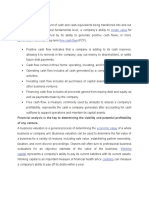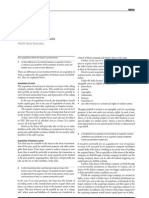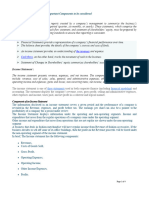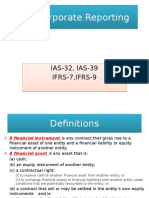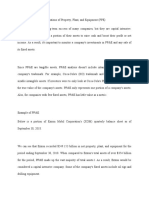Goodwill
Goodwill
Uploaded by
Jann Vic SalesCopyright:
Available Formats
Goodwill
Goodwill
Uploaded by
Jann Vic SalesCopyright
Available Formats
Share this document
Did you find this document useful?
Is this content inappropriate?
Copyright:
Available Formats
Goodwill
Goodwill
Uploaded by
Jann Vic SalesCopyright:
Available Formats
Goodwill
Goodwill in accounting is an intangible asset that arises when a buyer acquires an
existing business. Goodwill represents assets that are not separately identifiable. Goodwill does
not include identifiable assets that are capable of being separated or divided from the entity and
sold, transferred, licensed, rented, or exchanged, either individually or together with a related
contract, identifiable asset, or liability regardless of whether the entity intends to do so. Goodwill
also does not include contractual or other legal rights regardless of whether those are transferable
or separable from the entity or other rights and obligations. Goodwill is also only acquired
through an acquisition; it cannot be self-created. Examples of identifiable assets that are goodwill
include a company’s brand name, customer relationships, artistic intangible assets, and any
patents or proprietary technology. The goodwill amounts to the excess of the "purchase
consideration" (the money paid to purchase the asset or business) over the net value of the assets
minus liabilities. It is classified as an intangible asset on the balance sheet, since it can neither be
seen nor touched. Under US GAAP and IFRS, goodwill is never amortized, because it is
considered to have an indefinite useful life. Instead, management is responsible for valuing
goodwill every year and to determine if an impairment is required. If the fair market value goes
below historical cost (what goodwill was purchased for), an impairment must be recorded to
bring it down to its fair market value. However, an increase in the fair market value would not be
accounted for in the financial statements. Private companies in the United States, however, may
elect to amortize goodwill over a period of ten years or less under an accounting alternative from
the Private Company Council of the FASB.
You might also like
- Document GoodwillDocument7 pagesDocument Goodwillpragatisrivastav4022No ratings yet
- What Is Goodwill?: Key TakeawaysDocument4 pagesWhat Is Goodwill?: Key TakeawaysTin PangilinanNo ratings yet
- GoodwillDocument3 pagesGoodwillMark Erwin SalduaNo ratings yet
- GoodwillDocument4 pagesGoodwillmuhjaerNo ratings yet
- Goodwill NotesDocument13 pagesGoodwill NotesABHISHEK SINGH 2124600No ratings yet
- Valuation of GoodwillDocument36 pagesValuation of GoodwillAbhi94% (16)
- Accounting (Goodwill)Document17 pagesAccounting (Goodwill)PowerPoint GoNo ratings yet
- Merger-Buss PurchaseDocument2 pagesMerger-Buss PurchasemilhalyyNo ratings yet
- AcquisitionDocument2 pagesAcquisitionJai BhatiaNo ratings yet
- Valuation of Goodwill Cost AssignmentDocument12 pagesValuation of Goodwill Cost AssignmentShubashPoojari100% (1)
- PAS-38-INTANGIBLE-ASSETs-pdf-versionDocument24 pagesPAS-38-INTANGIBLE-ASSETs-pdf-versionfretzienalzaro13No ratings yet
- TERMS IN CONSOLIDATIONDocument5 pagesTERMS IN CONSOLIDATIONremmymariethaNo ratings yet
- Basic Accounting Terminology: Tangible AssetsDocument4 pagesBasic Accounting Terminology: Tangible Assetskavya guptaNo ratings yet
- Ifrs at A Glance: IAS 39 Financial InstrumentsDocument8 pagesIfrs at A Glance: IAS 39 Financial InstrumentsvivekchokshiNo ratings yet
- Basic Accounting TermsDocument8 pagesBasic Accounting Termsjosephinemusopelo1No ratings yet
- What Is Cash FlowDocument31 pagesWhat Is Cash FlowSumaira BilalNo ratings yet
- Financial LiteracyDocument4 pagesFinancial LiteracyFarhan KhanNo ratings yet
- Valuation GoodwilllDocument22 pagesValuation GoodwilllShubashPoojariNo ratings yet
- What Is An Intangible AssetDocument2 pagesWhat Is An Intangible AssetShin Darren BasabeNo ratings yet
- Functional AccountingDocument9 pagesFunctional Accountingayesha shafaqatNo ratings yet
- Accounting For Intangible Asset IAS 38Document2 pagesAccounting For Intangible Asset IAS 38MIKIYAS BERHENo ratings yet
- Module 1 - Business Combination (IFRS 3)Document15 pagesModule 1 - Business Combination (IFRS 3)MILBERT DE GRACIANo ratings yet
- Chapter 3 SolutionsDocument17 pagesChapter 3 SolutionsHarry YangNo ratings yet
- A3Document5 pagesA3raevincelleNo ratings yet
- HandoutDocument4 pagesHandoutZack CullenNo ratings yet
- Financial AssetDocument2 pagesFinancial Assetgabby209No ratings yet
- Accounting 1 - Module 7Document38 pagesAccounting 1 - Module 7CATHNo ratings yet
- Components of A Balance Sheet AssetsDocument3 pagesComponents of A Balance Sheet AssetsAhmed Nawaz KhanNo ratings yet
- PartnerDocument3 pagesPartnerLeyla PerezNo ratings yet
- Important HighlightsDocument2 pagesImportant HighlightsSyed Zeeshan ArshadNo ratings yet
- Ias 38-Intangible AssetDocument6 pagesIas 38-Intangible AssetTope JohnNo ratings yet
- Intangible AssetsDocument99 pagesIntangible AssetsXNo ratings yet
- SWIFT Notes To Financial StatementsDocument11 pagesSWIFT Notes To Financial StatementsArvin TejonesNo ratings yet
- Financial Asset: TypesDocument2 pagesFinancial Asset: TypesAngelie LapeNo ratings yet
- Financial Accounting and ReportingDocument37 pagesFinancial Accounting and ReportingDevesh GaurNo ratings yet
- Tax On Inbound Investment-SG-PJDocument4 pagesTax On Inbound Investment-SG-PJArjun BoseNo ratings yet
- IAS 39 Financial InstrumentsDocument9 pagesIAS 39 Financial InstrumentskwakyeNo ratings yet
- Financial Management DictionaryDocument9 pagesFinancial Management DictionaryRaf QuiazonNo ratings yet
- FRA CFA Level 2Document53 pagesFRA CFA Level 2shivbhaktajoshiNo ratings yet
- FINANCIAL STATEMENT For PrintDocument4 pagesFINANCIAL STATEMENT For PrintGkgolam KibriaNo ratings yet
- Accounts Part - ADocument4 pagesAccounts Part - Akaifm890No ratings yet
- Basic Accounting TerminologiesDocument3 pagesBasic Accounting TerminologiesSIVARAM E MBA (HOSPITAL & HEALTH SYSTEMS MANAGEMENT)No ratings yet
- Corporate Accounting Theory Unit 3Document3 pagesCorporate Accounting Theory Unit 3affinitienterprisesNo ratings yet
- Ias 38Document5 pagesIas 38Sreenidhi RemesanNo ratings yet
- Financial InstrumentsDocument29 pagesFinancial InstrumentsayeshaNo ratings yet
- Fixed Asset: Fixed Assets, Also Known As A Non-Current Asset or As Property, Plant, and Equipment (PP&E), Is ADocument7 pagesFixed Asset: Fixed Assets, Also Known As A Non-Current Asset or As Property, Plant, and Equipment (PP&E), Is ARandal SchroederNo ratings yet
- Asset & Its ClassificationDocument5 pagesAsset & Its ClassificationSyed Shaker AhmedNo ratings yet
- Goodwill Presented As Other AssetsDocument7 pagesGoodwill Presented As Other AssetsRegie Sharry Alutang PanisNo ratings yet
- Chapter 4Document4 pagesChapter 4luzespinosa602No ratings yet
- Classification of Financial InstrumentsDocument18 pagesClassification of Financial InstrumentsElena Hernandez100% (2)
- Business Com Theories (Q1)Document10 pagesBusiness Com Theories (Q1)수지No ratings yet
- InvestmentDocument39 pagesInvestmentJames R JunioNo ratings yet
- Tanmay AccountsDocument14 pagesTanmay AccountsShorya KingNo ratings yet
- Ias 38Document33 pagesIas 38Reever River100% (1)
- Lesson / Topic: Accounts Receivable Learning Target(s)Document8 pagesLesson / Topic: Accounts Receivable Learning Target(s)Kim FloresNo ratings yet
- Personal Assets: AssetDocument6 pagesPersonal Assets: AssetDipak NandeshwarNo ratings yet
- 02 Handout 1Document6 pages02 Handout 1Stacy Anne LucidoNo ratings yet
- Accounting Standard - 14Document13 pagesAccounting Standard - 14Manav GuptaNo ratings yet
- Wasting AssetsDocument2 pagesWasting AssetsJann Vic SalesNo ratings yet
- History and Purchase vs. Pooling-Of-InterestsDocument2 pagesHistory and Purchase vs. Pooling-Of-InterestsJann Vic SalesNo ratings yet
- 4 What Is An Internal AuditDocument1 page4 What Is An Internal AuditJann Vic SalesNo ratings yet
- Sources of LawDocument1 pageSources of LawJann Vic SalesNo ratings yet
- Doing Business in The PhillipinesDocument2 pagesDoing Business in The PhillipinesJann Vic SalesNo ratings yet
- Accounting For Property, Plant, and Equipment (PPE)Document1 pageAccounting For Property, Plant, and Equipment (PPE)Jann Vic SalesNo ratings yet
- Types of GoodwillDocument1 pageTypes of GoodwillJann Vic SalesNo ratings yet
- Goodwill's Modern MeaningDocument1 pageGoodwill's Modern MeaningJann Vic SalesNo ratings yet
- Limitations of Property, Plant, and Equipment (PPE)Document1 pageLimitations of Property, Plant, and Equipment (PPE)Jann Vic SalesNo ratings yet
- What Is An Internal AuditDocument1 pageWhat Is An Internal AuditJann Vic SalesNo ratings yet
- Internal Auditing: Definition of Internal Auditing International Professional Practices Framework (IPPF)Document2 pagesInternal Auditing: Definition of Internal Auditing International Professional Practices Framework (IPPF)Jann Vic SalesNo ratings yet















